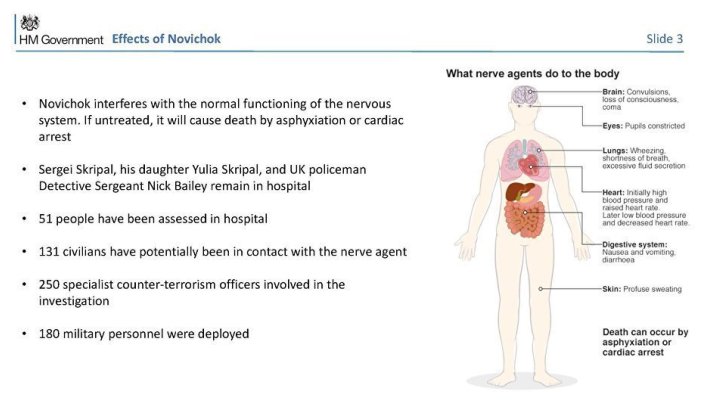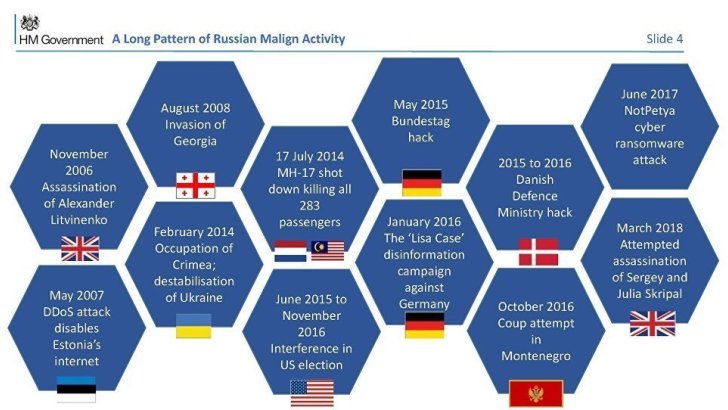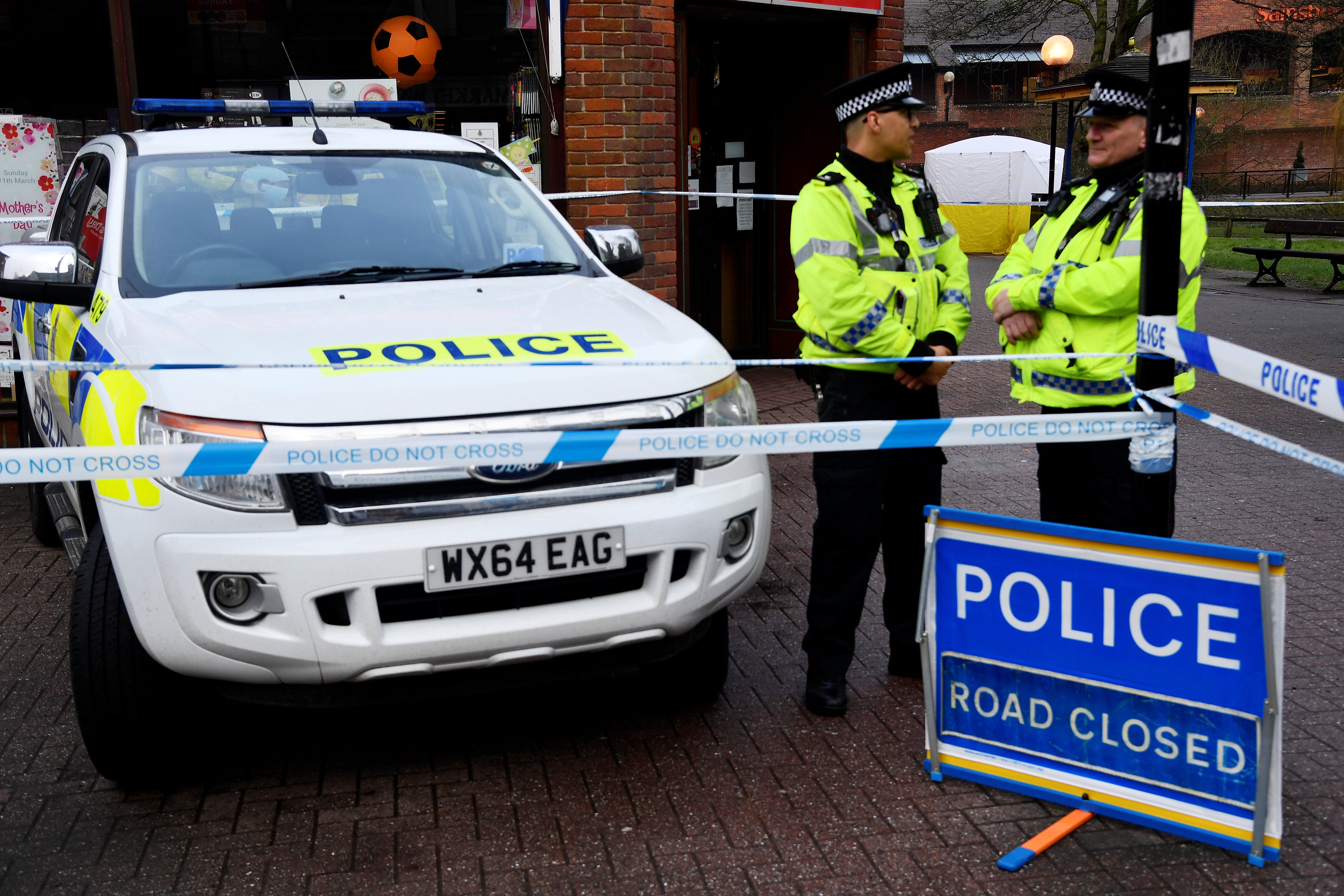By ALEX CHRISTOFOROU
The UK Novichok poisoning hoax continues to unravel, even as European puppet states expel Russian diplomats, so as to provide some cover and legitimacy to the UK government’s false flag nerve agent attack.
Russia’s Kommersant newspaper has obtained the document used by the British government to convince EU and NATO allies to expel Russian diplomats over the Skripal poisoning hoax.
The slideshow PPT presentation called the “Salisbury Incident” summarizes the UK’s version of events.
The Salisbury Incident PowerPoint presentation was reportedly sent out to 80 top-level foreign embassy officials in Moscow, including US Ambassador Jon Huntsman, who told Kommersant that he found Britain’s evidence “very convincing.”
Russian Foreign Ministry spokeswoman Maria Zakharova called the slideshow a “massive manipulation of world public opinion” on the basis of “6 pictures.”
The document is far from “convincing”, and resembles something that a 12 year old science student would put together, summarizing the Theresa May government’s propaganda over the last two weeks, into powerpoint (bullet point) format.
Anyone that says these four slides are “convincing” is a complete moron.
Sputnik News examines the facts behind the UK slide show PPT presentation.
We encourage our readers to take a look at these four slides and judge for yourselves as to how “convincing” the case is that Russia is behind the Novichok poisoning.
Faulty Timelines
The slideshow, which London has since confirmed is authentic, starts with a timeline, from Sergei and Yulia Skripal’s poisoning in Salisbury on March 4, to Prime Minister May’s declaration on March 12 that the substance used was the ‘Russian’ Novichok nerve agent and demand that Moscow provide an explanation.
Slide 1 of the Salisbury Incident presentation:

But a British High Court investigation into the incident was not so categorical, concluding Thursday that new blood samples needed to be taken from the Skripals to be sent for analysis by the Organization for the Prohibition of Chemical Weapons (OPCW). Court evidence from the Porton Down chemical weapons facility, cited by May in her attack on Russia, showed that scientists were not absolutely certain that the chemical the Skripals were exposed to was indeed Novichok. Nor could they rule out that the ex-spy and his daughter were poisoned by a “closely related agent.”
Court evidence aside, the PowerPoint presentation itself points out that Prime Minister May wrote to the OPCW asking for assistance on March 14, two days AFTER accusing Russia. The same day, London announced its ‘response’ to the poisoning, including the expulsion of 23 Russian diplomats, a break in high-level diplomatic contacts, and a ministerial and royal family boycott of the upcoming World Cup.
Finally, the slideshow confirms that the OPCW investigative team arrived in the UK a full week after May gave Moscow its 24-hour ‘ultimatum’ to Russia. On Tuesday, the organization confirmed that it has finished collecting samples from the scene of the crime, but stressed that its analysis would only be completed in two to three weeks’ time.
Contentious Claims
Slide 2 of the presentation, titled ‘A New Phase of Russia Aggression’, repeats London’s claim (debunked above) about Novichok being “positively identified by experts” at Porton Down. It goes on to say that Novichok is “developed only by Russia,” again, not true. Not only has the New York Times reported that the US has had access to the chemical since the late 1990s; on Sunday, the Russian Defense Ministry said it had evidence to show that A-234, the agent believed to have been used to posion Skripal, has also been created by the US. Russia itself stopped all research and development on the weapon after the collapse of the Soviet Union, and destroyed its stockpiles of the deadly agent.
Slide 2 of the Salisbury Incident presentation, titled ‘A New Phase of Russia Aggression’:

Ignoring these facts, the document goes on about the Skripal case being the “first offensive use of a nerve agent in Europe since the Second World War,” and concludes that Russia is “without doubt…responsible” for the crime. “There is no plausible alternative explanation,” it insists.
In other words, instead of offering evidence, waiting for the conclusion of an in-depth investigation, or taking up Russia’s proposal to conduct a full-scale joint investigation into the crime, London simply blames Russia. To Moscow’s consternation, the British government has even rejected Russia’s requests to provide it with investigative materials into the Skripal case, even though the attack also targeted Yulia Skripal, a Russian citizen.
Slide 3 summarizes the consequences of the poisoning attack, and offers a graphic showing what nerve agents do to the body; again, no evidence to suggest Russian involvement is offered.
Slide 3 of the Salisbury Incident presentation:

Blame It on the Bogeyman
Slide 4 of the government slideshow is the most audacious, adding eleven other egregious claims about “malign Russian activity” across the globe, without any evidence to back them up. Debunking these claims isn’t hard:
Slide 4 of the Salisbury Incident presentation, accusing Russia of a slew of crimes going back over a decade:

- The claim that Russia was behind the 2006 assassination of ex-spy Alexander Litvinenko has been contested not only by the Russian government, but by Litvinenko’s own father, who believes his son was killed by Alex Goldfarb, chairman of Boris Berezovsky’s Civil Liberties Fund.
- The claim about a Russian “invasion of Georgia” in 2008 is equally absurd. Not only did Georgian President Mikheil Saakashvili start the conflict by using artillery against his own people, but the Russian response was limited to protecting the Abkhazian and Ossetian minorities and recognizing these regions’ independence, and didn’t include marching to Georgia and toppling the Saakashvili government (which collapsed on its own in 2013, after which Saakashvili fled the country over embezzlement charges).
- The assertion that Russia ‘occupied’ Crimea and ‘destabilized’ Ukraine in February 2014 is not only factually wrong (Crimea broke off from Ukraine in March 2014), but ignores that Crimeans voted overwhelmingly to join Russia after the Maidan coup in Kiev in a referendum organized by Crimean authorities. As for the ‘destabilization of Ukraine’ claim, it would probably be more appropriate to consider Kiev’s actions in the aftermath of the coup, including its decision to send troops into the Donbass to attack independence supporters, and its continuing rejection of constitutionally-guaranteed autonomy for its eastern regions. As for Russia, it is a guarantor, not a participant, in the conflict in eastern Ukraine.
- The claim that Russia was responsible for the July 2014 downing of Flight MH-17 ignores Russian investigators’ conclusion that the Boeing was shot down from territory controlled by the Ukrainian military.
- As for the slideshow’s claim about Russian meddling in the US presidential election in 2016, it would be interesting to hear President Trump’s take on the allegation, which implies that he owes his victory to Russian interference. Furthermore, a recently concluded comprehensive report by Congressional investigators found no evidence of collusion between the Trump campaign and Russia.
- For the remainder of the claims, from Russian DDoS and hacking attacks, to its alleged support for a coup attempt in Montenegro in 2016, it is sufficient to point out that they all follow a consistent pattern: Step 1) accusations are made, with no evidence provided, followed by a political, media and diplomatic scandal. Step 2) the scandal blows over, the public forgets, and those making the accusations are never reprimanded.
Fake Claims, Real Consequences
As this article has pointed out, the Salisbury Incident document is not only light on facts, but contains absolutely no hard evidence about any Russian complicity in the crime against the Skripals. Instead, it’s limited to guesswork and easily disprovable stereotypes. Unfortunately, facts or not, the document has played its part in the decision of nearly 30 countries to expel over 100 Russian diplomats.
- Russian Foreign Ministry statement
- Ukrainian People’s Tribunal in Donetsk passes judgment upon Petr Poroshenko’s regime
- This Time It Will Be Very, Very Different






